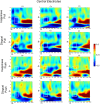Hold on Tight! Linking Emotions and Actions in the Infant Brain
- PMID: 40650966
- PMCID: PMC12255472
- DOI: 10.1111/infa.70029
Hold on Tight! Linking Emotions and Actions in the Infant Brain
Abstract
By the end of the first year, infants use others' emotions to interpret events, integrate social cues and build expectations on how people should behave (e.g., through social referencing). Yet, little is known about the neural correlates of linking others' emotions to following actions. This priming study investigates 10-month-old infants' electrophysiological responses to happy and disgusted emotional displays toward novel objects (prime) and subsequent actions (pushing away or pulling objects closer; target). Event-related potentials from 30 infants showed neural responses associated with emotional processing of the prime, such as heightened attentional response (Nc) and greater cognitive processing (Pc) in response to happiness over disgust. The target action of pushing away objects elicited increased slow wave activity when following happiness. Additionally, a significant mu-rhythm desynchronization, indicating motor resonance, was observed for pulling objects closer when preceded by happiness. Theta activity was higher for pushing away objects, indexing this as an unexpected event. These findings indicate that by 10 months, infants attend to emotional cues and use these cues to form predictions about subsequent actions. These neural correlates of bridging emotions and actions before 12 months of life reveal early neural sensitivity for processing social cues in complex contexts.
Keywords: actions; electroencephalography; emotions; infant cognition; social referencing.
© 2025 The Author(s). Infancy published by Wiley Periodicals LLC on behalf of International Congress of Infant Studies.
Conflict of interest statement
The authors declare no conflicts of interest.
Figures







Similar articles
-
Women are expected to smile: Preliminary evidence for the role of gender in the neurophysiological processing of adult emotional faces in 3-year-old children.Dev Psychobiol. 2024 Jan;66(1):e22443. doi: 10.1002/dev.22443. Dev Psychobiol. 2024. PMID: 38131242
-
Selective Action Prediction in Infancy Depending on Linguistic Cues: An EEG and Eyetracker Study.J Neurosci. 2024 Apr 3;44(14):e1301232024. doi: 10.1523/JNEUROSCI.1301-23.2024. J Neurosci. 2024. PMID: 38418219 Free PMC article.
-
Short-Term Memory Impairment.2024 Jun 8. In: StatPearls [Internet]. Treasure Island (FL): StatPearls Publishing; 2025 Jan–. 2024 Jun 8. In: StatPearls [Internet]. Treasure Island (FL): StatPearls Publishing; 2025 Jan–. PMID: 31424720 Free Books & Documents.
-
The Black Book of Psychotropic Dosing and Monitoring.Psychopharmacol Bull. 2024 Jul 8;54(3):8-59. Psychopharmacol Bull. 2024. PMID: 38993656 Free PMC article. Review.
-
The Lived Experience of Autistic Adults in Employment: A Systematic Search and Synthesis.Autism Adulthood. 2024 Dec 2;6(4):495-509. doi: 10.1089/aut.2022.0114. eCollection 2024 Dec. Autism Adulthood. 2024. PMID: 40018061 Review.
References
-
- Adamson, L. B. , and Frick J. E.. 2003. “The Still Face: A History of a Shared Experimental Paradigm.” Infancy 4, no. 4: 451–473. 10.1207/S15327078IN0404_01. - DOI
-
- Babik, I. , Galloway J. C., and Lobo M. A.. 2022. “Early Exploration of One’s Own Body, Exploration of Objects, and Motor, Language, and Cognitive Development Relate Dynamically Across the First Two Years of Life.” Developmental Psychology 58, no. 2: 222–235. 10.1037/dev0001289. - DOI - PMC - PubMed
MeSH terms
Grants and funding
LinkOut - more resources
Full Text Sources
Medical
Research Materials

